15 Discontinued Canned Foods You'll Probably Never Try Again
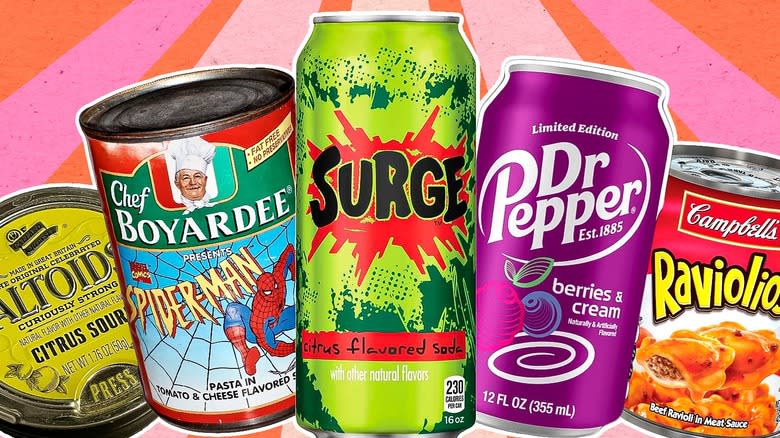
It's risky business to fall in love with any particular food product. You never know if your favorite snack will continue to stick around or if your passion for the item is a rarity, leading the manufacturer to pull it from the shelves. We've all experienced disappointment when one of our favorite treats or pre-packaged dinners goes missing from store shelves, never to return. That beloved food then becomes a memory — a testament to our younger years, with just the mere sight of the brand's logo conjuring nostalgia and leaving us to reminisce about simpler times. We long to taste our old favorites again, but trying to recreate the recipe at home never quite lives up to the real deal.
Many of those gone-but-not-forgotten classics were canned goods that graced our pantry shelves regularly. The process of commercial canning in America began in 1812, and since then, we've never looked back. According to PR Newswire, each American consumes about five cans of food each week, with canned tuna, soup, and corn among the most popular options. Canned food–in its convenient, non-perishable packaging–will likely never go out of style, even if some specific varieties don't retain their popularity and wind up in the snack cemetery. Let's take a trip down memory lane with this list of discontinued canned items and discover why they couldn't stand the test of time.
Read more: 25 Most Popular Snacks In America Ranked Worst To Best
Surge
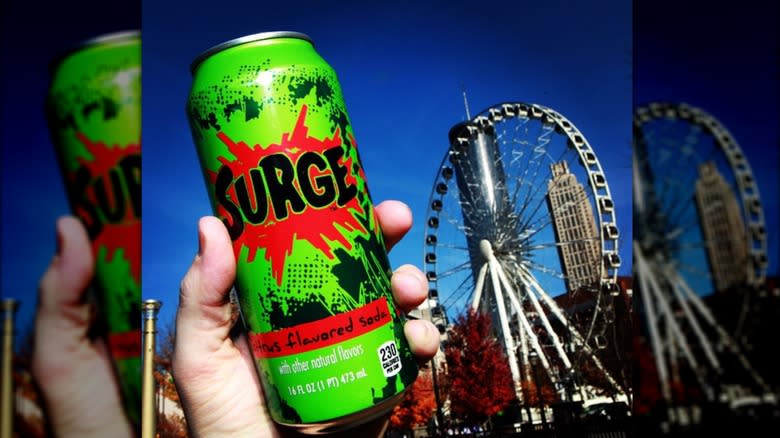
Ah, the '90s. Those of us who grew up during this glorious decade likely remember the plethora of exciting snack options to choose from. This included an assortment of fun sodas with exhilarating packaging designed to make you feel ready to take on the day. Coca-Cola's Surge, introduced in 1997, entered the scene to rival Pepsi during a lemon-lime soda craze fueled by the popularity of Mountain Dew. Surge outshone its Pepsi counterpart with its impressive energy-inducing capabilities, containing a whopping 54 milligrams of caffeine per can. In the '90s, the line between energy drinks and regular soda was blurrier than it is today, making caffeine consumption among kids more commonplace.
But why was Surge discontinued despite its popularity? The soda's glory days were short-lived, fading as extreme lifestyle branding lost its appeal. As the nation shifted its focus toward healthier food choices, concerns arose about Surge's sugar and caffeine levels, leading schools to remove it from vending machines and parents to become less inclined to purchase it for their children. But fear not, '90s kids — Coke brought Surge back in 2014, albeit in limited quantities. While the days of buying Surge by the case at your local supermarket may not return, you might still be fortunate enough to snag a can or two from select online retailers.
Franco-American Macaroni And Cheese
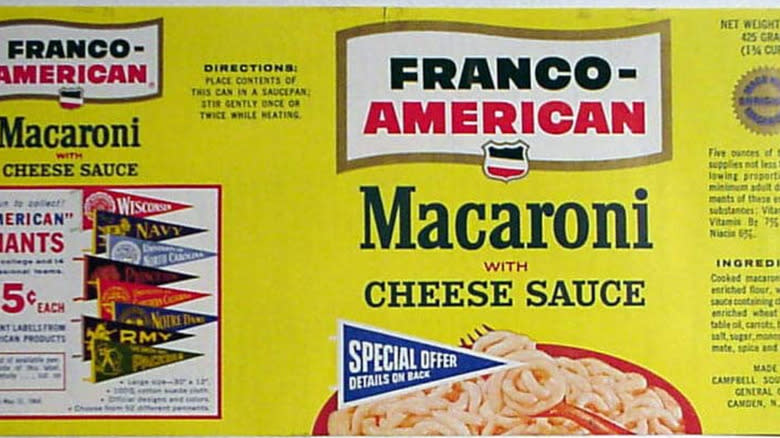
Macaroni and cheese might be the ultimate comfort food, so it's no surprise that someone somewhere decided to market a canned variety of the beloved pasta dish. Franco-American, a Campbell's company since 1915, introduced a canned macaroni and cheese that was loved by many in the '70s and '80s. Eventually, the fanfare surrounding this gooey mess of cheese sauce and long, spindly noodles died down, resulting in the discontinuation of the brand and its signature item in 2004.
As opposed to a more common variety of macaroni and cheese–with elbow pasta and a thick, dark yellow sauce made chiefly from cheddar–Franco-American was more like spaghetti noodles in a thin, syrupy sauce that appeared to be more milk and butter than cheese. For some, this was bliss; for others, this pasta dish warranted a hard pass. Lovers of this canned snack convene on Facebook, where they attempt to recreate the taste that they so fondly remember. Some have made what they deem worthy renditions using udon noodles, Campbell's cheddar soup or a homemade cheddar sauce, Alfredo sauce, and butter.
Chef Boyardee Pac-Man Pasta
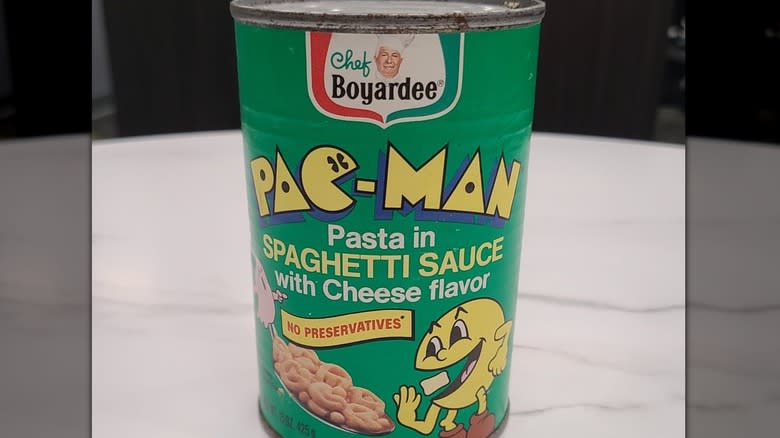
Back in the early '80s, video games were life. To get kids excited about anything, it had to relate to their favorite games in one way or another. Chef Boyardee cracked the code to get kids psyched for dinner by tying pasta and Pac-Man together using his simple, iconic shape. The Pac-Man pasta of the 1980s came in a few different varieties, including cheesy spaghetti sauce, sauce with meatballs, and an obscure flavor dubbed "golden chicken."
Chef Boyardee marketed its now discontinued canned item as containing three distinct noodle shapes: Pac-Man himself, Inky, Blinky, Pinky, and Clyde, and the little glowing dots that Pac-Man ate known as power pellets. Since the pasta noodles were only vaguely reminiscent of Pac-Man and his evil ghostly nemeses, it probably wasn't likely that the kids of the '80s tried to recreate a level of the famous game on their kitchen table. Instead, the image of Pac-Man on the can alone was enough to stoke the fires of one's appetite for this underwhelming meal. We'd like to think the kids at least said "wakka wakka" before every bite.
Pumpkin Spice Spam
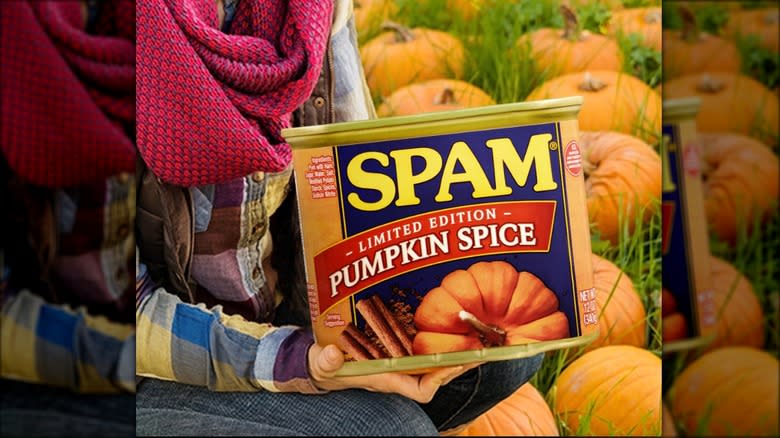
For the past few years, autumn has given way to a craze that grips the nation like no other. It looms around every corner, in every cafe, bakery, candle shop, and soap store, with a vice grip on everything flavored and scented. We're talking, of course, about pumpkin spice. There's hardly a single item that's safe from being pumpkin spice-ified during the autumn months, and this includes everyone's favorite convenient meat, with its iconic shape, color, and sizzle.
If you happened to be perusing the canned meats section of Walmart's website during the brief but electrifying height of pumpkin spice Spam, you likely did a double take when you stumbled upon the item. We don't blame you — it might be the most bizarre food ever to receive the pumpkin spice treatment. While Spam was hardly among the most delicious pumpkin spice items you could purchase during the fall season of 2019 (the only season it was available), it served as a humorous marketing tactic that worked in Hormel's favor. The seasonal tinned meat sold out online the day it was available for purchase. Obviously, the idea of cinnamon, nutmeg, ginger, and vanilla involved with ham seems pretty blatantly unappealing. But, according to Food and Wine, the product retained just a hint of the seasoning and tasted pretty good slathered in maple syrup or served in a sweet and savory breakfast sandwich.
Campbell's Pepper Pot Soup
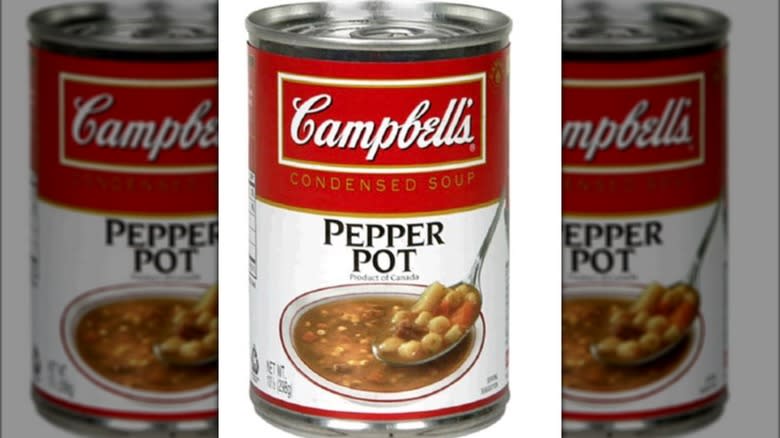
As the taste of the nation changes, brands must adapt and conform by leaving behind archaic recipes and substituting them for fresher fare. Campbell's pepper pot soup stands as one of the tried-and-true products of yesteryear that couldn't hold up to the changing times. As one of America's largest soup brands, Campbell's has retained many of its beloved soup varieties while it's known to eliminate the ones that miss the mark, leaving them to fade into obscurity. Ironically, Campbell's pepper pot soup had a cult following for 100 years until it was discontinued in 2010.
The pepper pot soup recipe, originating in the Caribbean and introduced to America in the 1700s, is primarily linked to the culinary heritage of Black Philadelphians and consequently became a staple dish in the city. The classic, cozy soup features beef honeycomb tripe and a variety of peppers, including some that bring a touch of heat to the dish. There's little not to love in this delicious winter warmer, so here's hoping that Campbell's will bring it back after the next particularly chilly Philly season.
Altoids Sours
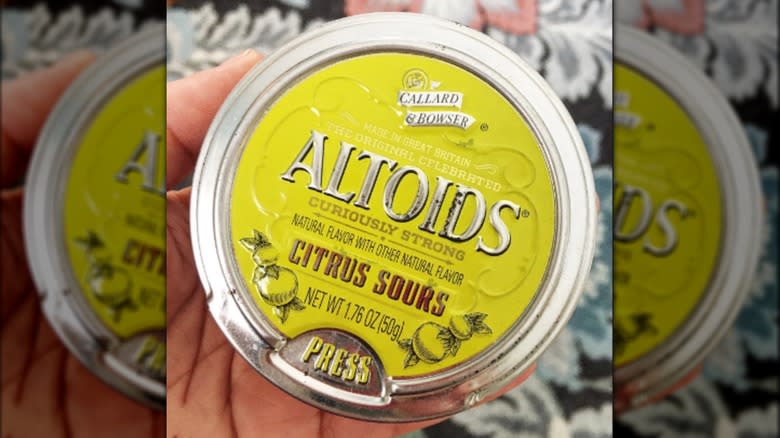
Sour candies — with their tang and tongue-burning ability — aren't for everyone. But for those who enjoy the pungent, lip-puckering taste, Altoids Sours were among the best. According to Bustle, the sweet and sour variety of the candy was introduced in 2004 as an alternative to the traditional minty Altoids for those who were after a more fun and fruity option. The candy appealed to kids, while the refreshing mint flavors were usually reserved for adults. Now, Altoids had something for everyone. Only the fun didn't last, and–to the dismay of a surplus of sour supporters nationwide–the candies were discontinued in 2010.
Altoids Sours came in diverse fruit flavors, including raspberry, citrus, mango, tangerine, and apple. Once the company announced that Altoid Sours would be no more, a campaign on Change.org was launched to bring back the most popular flavor: tangerine. The petition received over 18,000 signatures, but so far, the petitioner's efforts have been in vain. The makers of Altoids have yet to utter a peep about a potential return of the little tangy morsels, but our hope will never dwindle.
Chef Boyardee Tic-Tac-Toes
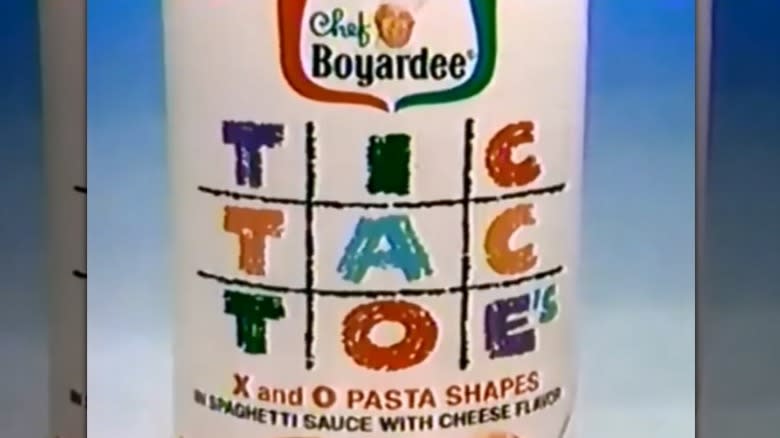
A testament to the devil-may-care attitude of the '80s lies in the decade's plentiful fun, tinned pasta options. Images of Chef Boyardee's Tic-Tac-Toes invoke a strong nostalgia for those who grew up in the decade when goofy food could be found in every supermarket aisle. Chef Boyardee pioneered turning dinner time into game time, getting kids excited for a meal while simultaneously providing ease and convenience for parents. Heat-and-serve dishes were often an American family's go-to dinner choice, and Tic-Tac-Toes are among the most iconic.
Chef Boyardee aired many exciting TV advertisements to get American kids thrilled about pasta, with the ad for Tic-Tac-Toes being the most zany and hilariously '80s of them all. But in reality, Tic-Tac-Toes were nothing more than O or X-shaped pasta noodles in a plain tomato-based sauce. Yet a child's imagination transformed them into something much more delightful, somehow turning a sad, bland noodle bowl into a joyous romp.
Daisys And Whistles
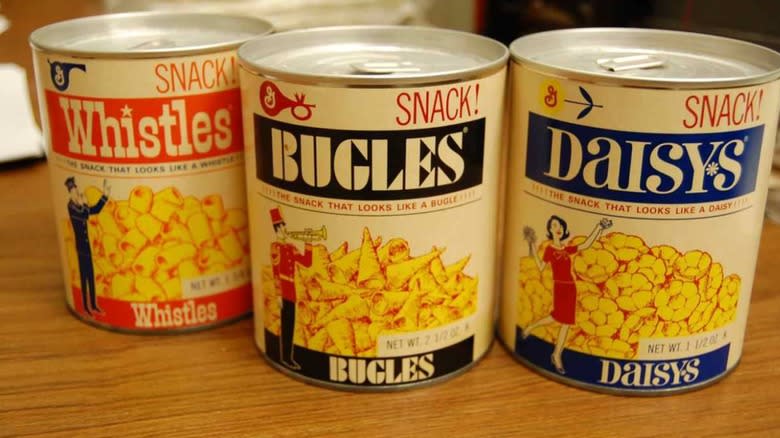
In May of 1964, Bugles — the cornucopia-looking snack from General Mills — first arrived on the market and has since become a household name in iconic snack foods. But many don't realize that the crunchy snack with the famous shape and even more renowned flavor first appeared on the scene as a trio. Accompanied by Daisys and Whistles, the three chips together were ready to take on the world. But, as you can probably guess based on the nature of this list, only one of the three survived the plight of the discontinued canned item to continue conquering the ever-changing market of American snacks.
The three chips shared the same flavor, with Daisys resembling flowers and Whistles taking on a tubular shape. However, only the horn-shaped Bugles managed to maintain popularity. In the 1960s, Bugles, Daisys, and Whistles were available in either boxes or pop-top cans. Today, Bugles are exclusively packaged in various sizes of red chip bags. Over time, it became apparent that aluminum can packaging for finger foods was both unsafe and inconvenient, leading most snack brands (looking at you, Pringles) to adopt safer and more convenient bag packaging.
Campbell's Scotch Broth Soup
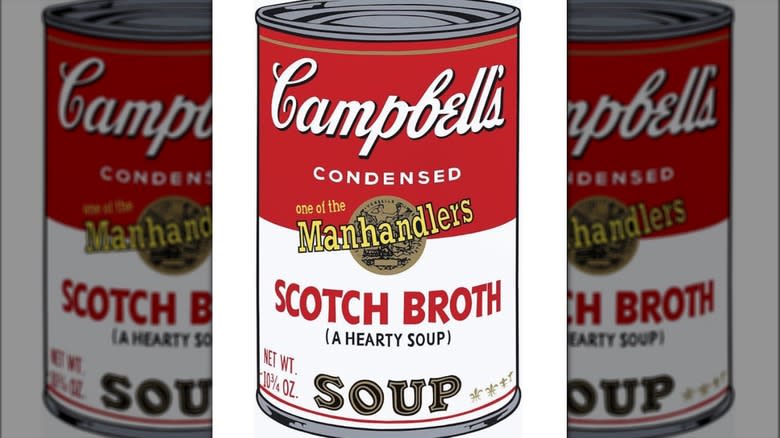
Perhaps too primitive for the modern world, Scotch broth soup keeps company with the brand's pepper pot soup in Campbell's graveyard. With a recipe dating back to 1700s Scotland, this hearty, feel-good soup was a fan favorite among Campbell's enthusiasts back in the day, but it has since been discontinued to make room for more stylish soup selections. The soup boasted a unique spin on boring beef and barely, featuring lamb and unconventional seasonings that aren't found in other Campbell's products.
Originally, Scotch broth soup contained beef or mutton, barley, split peas, onions, herbs, and various vegetables like carrots and rutabagas. The Campbell's variety was satisfying enough to make a complete dinner all on its own. Those who made the canned classic a regular part of their nightly routine had to either switch to a similar option or learn to craft a homemade version. A made-from-scratch Scotch broth soup is well worth the effort and exceptionally superior to Campbell's version (with the right recipe, of course).
Canned Snack Pack Pudding
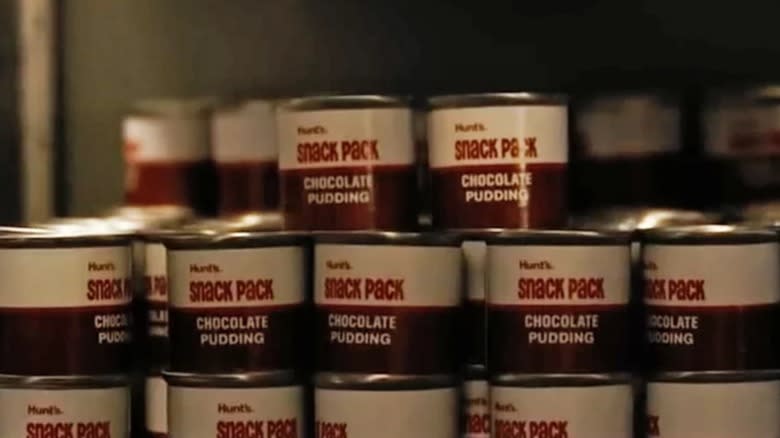
Arguably, the most worthwhile part of school lunch was the Hunt's Snack Pack pudding that your parents probably added to your lunchbox to act as the epic finale to your ham sandwich and carrot sticks. It seemed every kid had one of these come lunchtime, usually in the classic chocolate or vanilla flavor. But, if your parents had gone the extra mile to seek out the butterscotch flavor for your post-lunch dessert, you would have to guard it with your life — or at least resist every other kid's offer to trade for a likely lesser treat. Although most of us have these pudding-fueled memories, only Gen-Xers remember when the famous treat came in a can rather than a flimsy plastic cup.
Back in the 1970s, no kid could get enough of these little cylindrical tins or the creamy treat they held. But the times have changed; this item is kept in the grocery store's refrigerator section, and for good reason. Not only is the concept of shelf-stable pudding a little disturbing but giving a child a gloppy, oozing treat to devour straight out of a tin can is absolutely terrifying.
Campbell's Raviolios
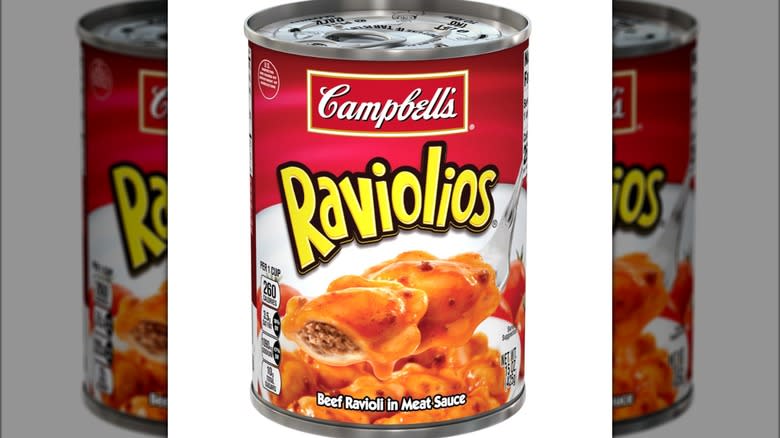
You're likely familiar with Campbell's trendy yet humble SpaghettiOs product line. Nowadays, SpaghettiOs are available in various flavors, with or without meat. This canned delight is strongly associated with childhood nostalgia. However, the lesser-known Raviolios also evoke joyous memories for some, although its fandom wasn't strong enough to keep it around permanently, unlike its spaghetti counterpart.
It's no secret that Chef Boyardee dominates the canned ravioli market, and for good reason. Chef Boyardee's little meat-stuffed pasta pillows are plump, delectable, and filled with juicy beef and tangy sauce. Campbell's, with its much punier ravioli, just couldn't keep up. SpaghettiOs championed Campbell's line of playful, geared-towards-kids pasta with its classic shape and texture that make it both slurpable and delicious. But when it comes to ravioli, survival of the fittest is part of the natural process of buying and selling consumer goods in a free market economy, and poor Raviolios fell victim to capitalism.
Chef Boyardee Spiderman Pasta
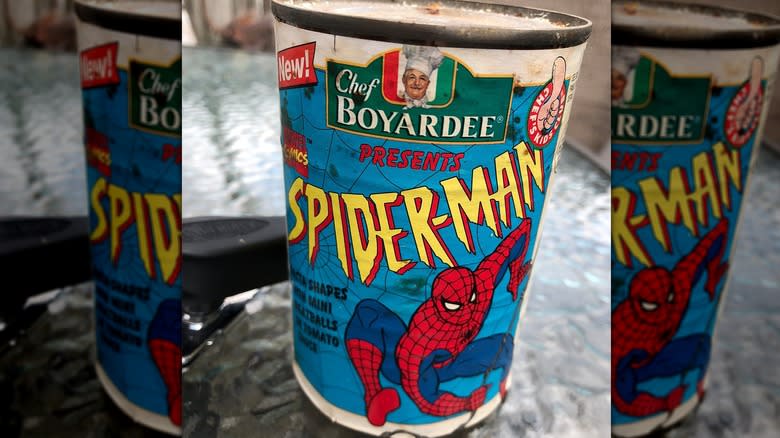
Speaking of the king of canned pasta, Chef Boyardee was no stranger to cranking out promotional products that got kids stoked for dinner while encouraging them to watch the hottest new show or play the trendiest new game. In 1994, the Spider-man animated series launched, and subsequently, the pasta that paid homage to everyone's favorite web-slinger hit store shelves. Superhero cartoons and goofy canned pasta stand as two iconic symbols from the decade, so this tinned, tomatoey treat may be the most quintessential '90s food product on this list.
This Marvel-inspired pasta product featured noodles in the shape of spiderwebs, the Spiderman mask, and Spiderman himself. Not to criticize Chef Boyardee, but these pasta noodle shapes required a bit of imagination if you really wanted to immerse yourself in Peter Parker's world. The mask and web, for example, looked almost identical, while the Spiderman pasta noodle really just resembled the vague outline of any regular person. Luckily, this pasta was geared toward children — probably those with vivid imaginations and low expectations.
Dr. Pepper Berries & Cream
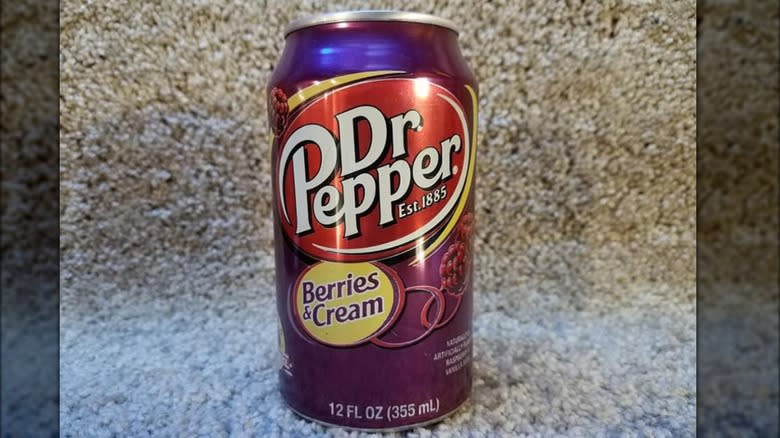
Most of us know Dr. Pepper as the 23-flavor soda, or, if you'd prefer, the soda that tastes like the concoction you used to make when you mixed every soda option from the fast-food drink fountain. It's uncommon to see a variety of Dr. Pepper besides the classic flavor out in the wild, but if you're lucky, you might be able to snag a unique one — unfortunately, this doesn't include Dr. Pepper berries and cream soda any longer.
Released in 2006, this soda was only available for about a year and a half before being sentenced to the scrapyard. The drink had a hint of the classic Dr. Pepper taste accompanied by raspberry and blueberry flavors and finished off with a rich, smooth creaminess.
In 2022, to the delight of the few who still remembered the drink, Dr. Pepper brought this long-forgotten variety back for a limited time. But, there was a catch: In order to get your hands on a can, you needed to win it in a sweepstakes, which involved joining Dr. Pepper's rewards program. This proved to be a giant letdown for soda enthusiasts around the nation. But, for those that love the berry-and-vanilla blend, Dr. Pepper now has a strawberries and cream variety that — while not the same as the original berry Dr. Pepper — may still fill the almost two-decades-old void.
Top Ramen Chicken Pringles
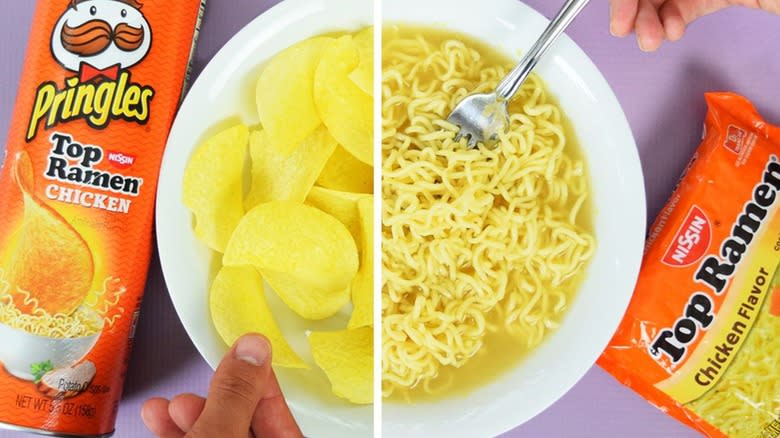
Top Ramen and Pringles once collided to give us the snack mashup of the century (or at least of 2017, when the chip was released). Chicken-flavored Top Ramen, arguably the most revered among instant ramen varieties, boasting a vibrant yellow-orange hue and a savory, salty poultry essence, collaborated with the potato chip that isn't really a potato chip to create a product that stood out in the snack aisle.
The unmistakable flavor of chicken instant ramen might take you back to your college days, reminding you of whipping up a quick dinner in your dorm over a little electric hot plate. Meanwhile, the crispy treats in the tubular can are universally adored, making this mashup one for the snack history books. Often, collaborations like these fall short of delivering a burst of flavor that truly resembles the real deal, but the Top Ramen chicken Pringles tasted identical to the real thing.
Four Loko With Caffeine
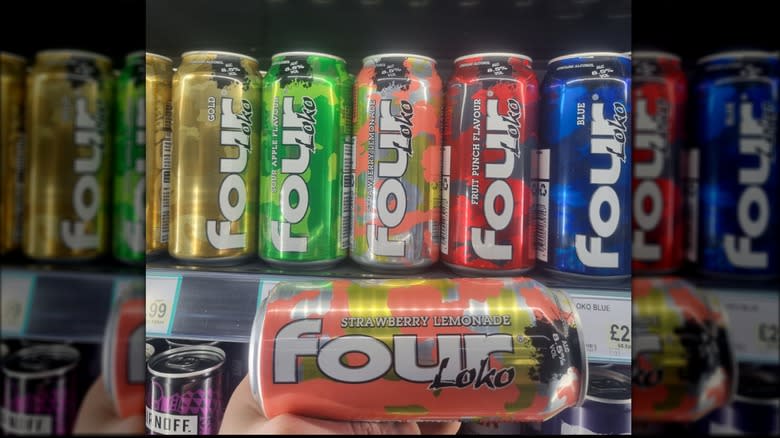
Four Loko, otherwise known as "blackout in a can," is alive and well, still sold at gas stations and liquor stores nationwide, and still contributing to many a regretful morning. But what some younger, unseasoned drinkers may not know is that Four Loko was once a bona fide energy drink while still containing a substantial amount of alcohol. To the dismay of those who enjoyed partying all night but to the relief of the worried parents, the company that produces Four Loko removed the caffeine from the product after many legal back-and-forths, eventually relegating it to the fate of many discontinued canned items.
At about as much alcohol as four beers and as much caffeine as 12 ounces of coffee, these tall boys packed an invigorating, intoxicating punch. Drinkers were able to stay up into the early hours of the morning and continue drinking without passing out from their alcohol consumption. In 2010, the malt beverage in the camo can became just like any regular sweet, boozy drink, leaving us with only our hazy memories of the Four Loko of the past.
Read the original article on Tasting Table.

